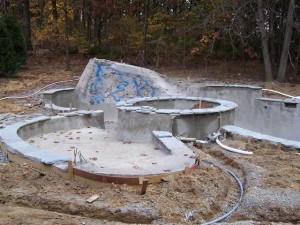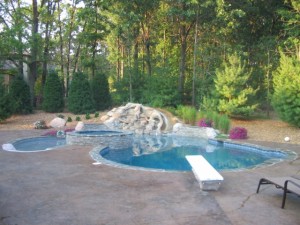
I thought it was concrete?
You’re right, sort of. Here’s everything that you wanted to know about gunite, shotcrete, and concrete (thank you wikipedia).
Before we get into that, the photo on the right is of a gunite pool in Highland, MI built by Legendary Escapes. The pool was formed, and then shot in gunite, as was the base for the waterfall that you see in the background. The gunite surface was then finished with pebble. Sometimes pebble is used. Others a white marcite coating will be used to seal the gunite surface.

Shotcrete is concrete (or sometimes mortar) conveyed through a hose and pneumatically projected at high velocity onto a surface, as a construction technique.
Shotcrete is usually an all-inclusive term; gunite is a term sometimes used for some dry-mix types.
Shotcrete undergoes placement and compaction at the same time due to the force with which it is projected from the nozzle. It can be impacted onto any type or shape of surface, including vertical or overhead areas.
Shotcrete, then known as gunite, was invented in the early 1900s by American taxidermist Carl Akeley, used to fill plaster model of animals. He used the method of blowing dry material out of a hose with compressed air, injecting water at the nozzle as it was released. This was later used to patch weak parts in old buildings. In 1911, he was granted a patent for his inventions, the “cement gun”, the equipment used, and “gunite”, the material that was produced. Until the 1950s when the wet-mix process was devised, only the dry-mix process was used. In the 1960s, the alternative method for gunning by the dry method was devised with the development of the rotary gun, with an open hopper that could be fed continuously. Shotcrete is also a viable means and method for placing structural concrete.
Shotcrete is today an all-inclusive term that describes spraying concrete or mortar with either a dry or wet mix process. However, it may also sometimes be used to distinguish from gunite as a wet-mix. The term shotcrete was first defined by the American Railway Engineers Association (AREA) in the early 1930s.[1] By 1951, shotcrete had become the official generic name of the sprayed concrete process.[1]
Gunite refers only to the dry-mix process, in which the dry cementitious mixture is blown through a hose to the nozzle, where water is injected immediately before application. Gunite was the original term coined by Akeley, trademarked in 1909 and patented in North Carolina. The concrete is blasted by pneumatic pressure from a gun, hence “gun”-ite.
The term “Gunite” became the registered trademark of Allentown, the oldest manufacturer of gunite equipment. Other manufacturers were thus compelled to use other terminology to describe the process such as shotcrete, pneumatic concrete, guncrete, etc. Shotcrete emerged as the most commonly used term other than gunite, and after the later development of the wet process came to be used for both methods.
Bet you’re glad you know that now, huh?
